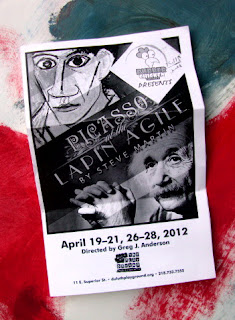The idea later emerged to include the visual arts as part of this creative experience. Three years ago this was discussed and it came to pass. In 2012 there is more art than last year and who knows how far it will go. Jeredt Runions has been part of the impetus behind the Homegrown Arts wing of this all-encompassing display of local talent.
EN: What is the Homegrown Art Festival and what
is its relationship to the Homegrown Music Festival?
Jeredt Runions: The art portion of Homegrown this year has been a work-in-progress for
three years now. I’ve been putting on group shows during homegrown for many
years because I felt that music and art up here in the Twin Ports should be
presented together or at least inspire one another. Finally, the homegrown crew
decided to include it officially this
year. I’ve been involved with the music scene for a long time now so it is
natural for me to think this way, I guess. After three years and showing people
I’m serious when I say I’m putting on a group show full of awesome talented
artists.
EN: How did you first become interested in art
and especially painting?
JR: Art is what I
live off of I think. I was raised with art everywhere, a crafty mother and a
wild-thinking step dad. My good friend
Gary Reed, my friends and family I considered inspirational during my tender
years of growing up. I picked up a paint brush literally to save myself from a
crazy path I was heading down in life with drugs. I personally think it was
amazing what art did for me to vent and express what I was going through then
and now. Painting just came so naturally
for me at that time, and I took to the styles of Graffiti and this cartoonish
aspect that I really loved.
EN: Do you have any live painting gigs lined up?
How does live painting differ from painting in your studio space?
JR: I have some
live painting gigs lined up for the summer. I will be at Harmony Park for the Bella
Festival at the end of May and then some in Iowa in June. Live painting is a fun way to practice your
confidence and quickness in composition. It just brings me back to the days of
when I used to run around the city and countryside creating quick street art. I have also noticed my timed sketches in
school have improved greatly because of my past with live painting. The studio art is just really great to sit
back and take your time. I like not having anyone shout to put something stupid in the work like a
heart or their girlfriend’s name.
EN: You also curate shows. How did you get into that
facet of things?
JR: I feel that curating
shows is part of my public duty so to speak. I’ve had so many people help me
out in the long run of my career, but I never forget the people and galleries that
couldn’t give a crap. I feel that I can
make a difference in doing this little thing. For the longest time I never saw
any group shows being put on. It was sad; I had to change that message that the
gallery scene wasn’t doing here. I never received any help from the galleries that
should have stepped up in those days. I was a young kid pushing boundaries in a
town full of seagull and lighthouse art, but knew there were more artists like
me than the ones that were down in Canal Park being displayed to the tourists. Time and patience show that a scene can build
if you establish a network of like-minded people and continue to push limits. Now
we have galleries that are helping to create a dream I and others have had here
in the Twin Ports. Galleries and people
such as Ochre Ghost, Prove, Phantom Galleries Superior, Anne Dugan from the DAI, Andy P. from Goin’
Postal, writers and critics such as you and Ann Klefstad.
 EN: When did you begin incorporating collage and
mixed media into your work and what is it you find interesting about this form
of expression.
EN: When did you begin incorporating collage and
mixed media into your work and what is it you find interesting about this form
of expression.
JR: I have always
mixed collage in with my work but have really enjoyed it now that I’m in UWS.
This school is a collage incubator. I really enjoy the quick pleasure of
collaging. It is just like my abstract backgrounds I use. I find it very
rewarding when you have some time in the day to make a piece of art. This is my
quick fix for the break in the day.
EN: What are the dates and places where
Homegrown Art can be seen? Do you have a list of artists whose work will be in
these various places?
JR: There will be a show at the DAI that Anne put on which will
be showing on Sunday the first day of Homegrown. It starts at 5 p.m.
The shows I curated this year for Homegrown Art are: "Rent Money" at the Zeitgeist Arts Building Atrium, "Local Walk" at the Duluth Photography Institute, "Soup Town" at the Red Mug, "Abstract Obscure" at the Ochre Ghost and Beaners, and "Saturday Morning Cartoons" at the PROVE.



















































